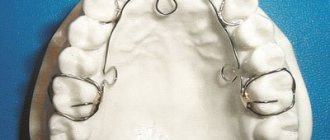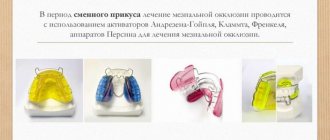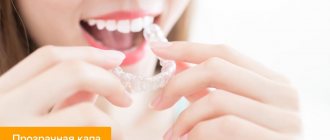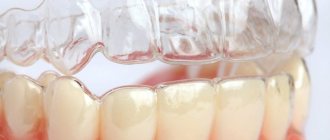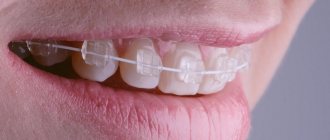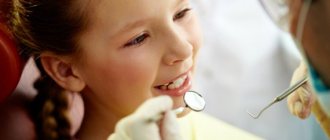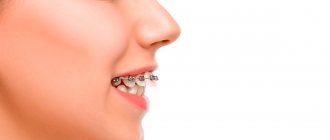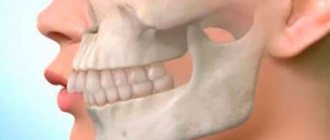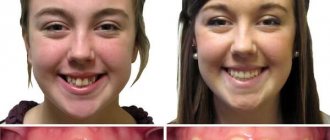An abnormal bite and crooked teeth are not only an anatomically incorrect position of the teeth on the jaw. This is the source of a whole range of problems affecting the health of a number of organs and systems that determine the psychological state of a person. Problems associated with bite are classified as chronic, which is why the patient often does not realize the severity of his condition and does not connect the existing discomfort with the condition of the oral cavity. But in vain.
How is the condition of your teeth related to your overall health?
While a person is young, his body has a significant “margin of safety”, thanks to which many problems are in a state of compensation for a long time. At the level of the oral cavity, the incorrect position of the teeth is compensated by changes in the tone of the masticatory muscles, increasing the load on the joints of the lower jaw and periodontal tissue. With age, teeth that are positioned incorrectly on the jaw begin to wear out and decay faster, increasing the likelihood of developing periodontal disease, their loosening and loss.
Insufficiently thorough chewing of food reduces the efficiency of the digestive system. Crowding and mismatch of the chewing surfaces of the antagonist teeth of the upper and lower jaws contribute to the accumulation of bacterial plaque and the rapid development of caries. Changes in the tone of the facial muscles and incorrect position of the jaws relative to each other have a negative impact on posture. Damage to the temporomandibular joint can cause chronic headaches.
Increased sensitivity after the procedure
Many patients who have had their teeth filed complain of increased sensitivity, especially when eating hot and cold dishes and hard foods.
Dentists explain this phenomenon as follows. Dentin, located under the enamel, is penetrated by many tubules, inside of which nerve endings are located. As the thickness of the enamel decreases, pressure changes occur, which can cause pain when taking certain foods.
To reduce tooth sensitivity after the procedure, dentists recommend temporarily avoiding too hard foods, dishes with high and low temperatures, and acidic drinks.
During oral hygiene, you should use a brush with soft bristles and therapeutic and prophylactic toothpaste, rinses for sensitive teeth.
If sensitivity does not disappear a week after filing, you should contact your dentist.
Indications and contraindications for orthognathic surgery, recovery time.
In this article we will tell you how to install braces on crowns.
Follow the link https://orto-info.ru/ortodonticheskoe-lechenie/podgotovitelnyiy-period/informativnost-telerentgenogrammyi.html if you are interested in the importance of a teleroentgenogram in orthodontics.
Occlusion and the psychological state of a person
The standard of beauty is perfectly straight white teeth. Depending on how close a person’s smile is to the ideal, the attractiveness of a particular individual to others is determined. You can talk as much as you like about spiritual beauty, but it is often not possible to see it behind its repulsive appearance. Crooked teeth, a significant amount of deposits, and a pronounced decrease in the height of the crowns determine not only the attractiveness, but also the age of the patient. The worse the teeth, the older the person is in the perception of other people.
An unaesthetic appearance of a smile causes difficulties in interpersonal communication, a feeling of embarrassment, awkwardness, and the formation of psychological complexes. At the same time, there is no need to constantly worry about your own imperfections. If previously it was possible to correct a bite only in childhood and adolescence, now there are no restrictions for orthodontic correction. And now there is no need to even wear braces. Aligners can be used on patients of all ages.
Contraindications
The necessity and admissibility of filing teeth is determined by the dentist individually in each case, since the procedure is quite labor-intensive and can be traumatic in some situations.
For this reason, sewing hard fabric is contraindicated in the following situations:
- increased abrasion of enamel;
- hyperesthesia;
- bruxism;
- presence of bad habits - frequent chewing of seeds and nuts, opening bottles with teeth;
- high risk of injury to the incisors, for example, boxing and other types of wrestling.
Correction of bite with mouth guards
Aligners, also known as transparent aligners made of a polymer transparent biocompatible material, are made for the patient on an individual basis. They fully take into account the anatomical features of the structure of a particular dental system, which makes it possible to effectively eliminate existing disorders. The process of manufacturing aligners is quite labor-intensive, which affects the cost of the products and the time spent on orthodontic correction.
Manufacturing of aligners includes:
- complete sanitation of the oral cavity;
- taking dental impressions;
- making trays from impressions in the laboratory.
The thickness of the aligners does not exceed 1 mm. Thanks to the special properties of the materials, the aligners are not visible on the teeth even at close range, and do not cause glare in the sun or when photographing using a flash.
Aligner capabilities
Unlike braces, the capabilities of polymer trays are somewhat limited. However, don't let this bother you. Not all patients of an orthodontist have a malocclusion so serious that they cannot do without braces. In most cases, a softer and gentler effect on the dentition is enough to improve the appearance of the smile area.
What anomalies can aligners treat:
- incorrect position of individual teeth;
- the need to perform extrusion or intrusion of teeth;
- crowding or, conversely, sparse position of teeth on the jaw;
- crossbite;
- unexpressed degree of deep bite.
Mouth guards will not cope with distal or mesial bite, since the development of these anomalies is based on the uneven development of the upper and lower jaws. In fact, this is the only limitation of the technique.
How much does it cost to straighten teeth without braces with orthodontist A. A. Arzumanov?
At an appointment with orthodontist Andranik Arkadyevich Arzumanov, the patient receives advice on possible correction of malocclusion without braces. After a complete diagnosis, at the patient’s request, teeth are straightened with aligners. The prices for the devices used are presented in the table.
Orthodontic treatment without braces - with aligners
| Name of service | Price, rub. |
| Orthodontic treatment using an aligner (up to 5 drops) | 50 000 |
| Orthodontic treatment using an aligner (up to 10 drops) | 80 000 |
| Orthodontic treatment using an aligner (up to 20 drops) | 130 000 |
By using alternative methods of teeth straightening, minor bite pathologies can be corrected or masked; however, only braces can effectively cope with severe anomalies.
Benefits of aligner treatment
Why are many people afraid of having braces? Mainly because this design creates a lot of inconvenience in everyday life. It is unaesthetic, difficult to care for, imposes significant restrictions on the choice of food products, and causes significant discomfort and pain immediately after installation and after each activation procedure.
All this is irrelevant for patients with aligners. The mouth guards can be removed for cleansing, eating, or attending a significant event. They do not affect diction, which is very important for people who often speak in public. You can take pictures with them, smiling “with all 32 teeth,” communicate, kiss. In general, live a normal life and not feel any restrictions.
In addition, aligners have other strengths:
- the material from which the mouthguards are made does not absorb pigments from food and drinks, and therefore does not darken over time;
- biosilicone is a hypoallergenic material, so it can be used without the risk of complications even in people with polyvalent allergies;
- uniform distribution of pressure over the entire surface of the dental crown provides a softer and more gentle effect on periodontal tissue;
- the absence of discomfort and restrictions contributes to maintaining high motivation and adherence to treatment on the part of the patient until the very end of the correction course;
- the final result of the correction is known in advance, since all stages of treatment are planned using a special computer program.
Diagnosis of anomalies
There are obvious cases, such as a pronounced diastema or torsion, you can notice them yourself when standing in front of a mirror. But there are also minor disorders that are no less dangerous to health, and only a specialized doctor can identify them.
Usually, hidden defects are easily recognized by a dentist - when he conducts a preventive examination, removes plaque or places a filling. Then he describes the problem and gives a referral to an orthodontist, who will determine how to straighten the jaw, bite, and a couple of adjacent teeth. To do this, a specialist will conduct a thorough examination of the patient’s mouth with a computed tomography or x-ray.
The anomaly can also occur during life, for example, after injury. Therefore, it makes sense to visit a doctor regularly, every six months, so that he either confirms that everything is in order, or promptly notices unwanted changes, which are easier to stop at the initial stage.
Surgical bite correction
Another way to correct the position of teeth in the jaw is to perform orthognathic surgery, during which the size and position of the jaws are changed. The operation is preceded by a period of wearing braces. The orthodontic structure will have to be worn for a certain time even after the intervention.
Surgery is indicated for patients only in extreme cases when braces as an independent method of correction cannot correct the patient’s anomaly. The intervention is performed in a hospital setting as planned after a period of preliminary preparation. You will have to spend several weeks in a hospital bed, since the recovery period is quite difficult and the patient requires constant medical supervision.
General conclusion
- 1. There is no universal way to correct a bite without the help of braces.
- 2. Each of the alternative methods may not be suitable in a particular clinical case.
- 3. Do not try to correct your bite on your own; be sure to have a personal consultation with an orthodontist!
To make a decision, contact our clinic with highly qualified orthodontists. Make an appointment with us for a consultation or call. Our clinic is located at St. Petersburg, Thorez Ave., 95.
Posted by:
Artistic restoration of teeth
If there is no time or opportunity to fix a defect, it can be disguised. It is not advisable to put on braces or spend money on a set of aligners for the sake of 1-2 crooked teeth. You can change the appearance of dental crowns using composite materials. In this way, you can remove scars and diastemas, visually lengthen your teeth, and correct the cutting edges of your teeth.
Artistic restoration can also be used after treatment with orthodontic structures in order to bring the result to perfection, cover areas of enamel damage when removing locks, and disguise other defects.
As you can see, braces are not the only way to achieve a perfect smile. They are not suitable for everyone and not everyone needs them. To choose the most effective way to eliminate defects in the dentition, you can contact an orthodontist and listen to his opinion.
In what cases is grinding necessary?
As we have already said, veneers are used to correct minor defects in the dentition - for example, chipped teeth, curvature of one or two teeth, as well as diastema. The main disadvantage of this method is the grinding of dental tissue to remove all irregularities. In addition, if you do not prepare your teeth before installing veneers, then after prosthetics they will look too convex and unnatural.
The structures themselves will last about ten years, after which they must be replaced with new ones, since turning teeth is an irreversible process.
Important!
To fix the veneers, the patient’s teeth are ground down by approximately 0.3 - 0.7 mm.

